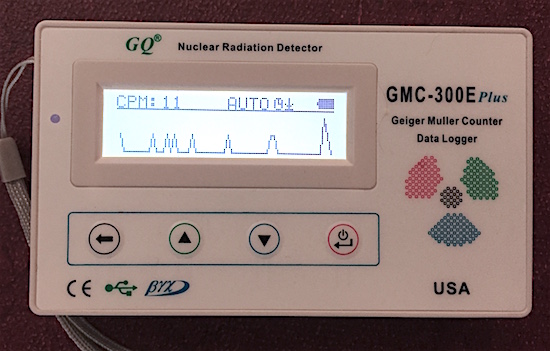
*Quick Look: GQ GMC-300EPlus Geiger Counter*
By: wmerrin
31 January 2018
Recently I was made aware of an interesting $100 (+/-) Geiger counter that seemed to have some nice features for its price point. One was available as a return at a nicely discounted price so I decided to test it as a candidate for casual use. The idea was for things like checking found objects such as antique uranium glass, old Fiestaware style dinnerware, radium dial clocks/watches, minerals in rock shops, etc for incidental radioactivity. Hobbyists call this "Urban Prospecting". But before I tell you what it is, let me say what it is not. The GQ GMC-300EPlus is not a "War Meter" that will survive (or even work) in high radiation environments like you might find on a battle field or following a nuclear attack. It is not a highly sensitive laboratory instrument for testing your fish dinner for contamination. It does not have NIST-traceable calibration to demonstrate compliance (or non-compliance) with any standards and it doesn't do isotope identification. You don't get those features for $100.

What it is, though, is a compact unit that combines several features that can come in handy on occasion. It provides the usual ratemeter function with readout in counts per minute, microsieverts per hour or mRem per hour and it has the usual alarm function to warn of elevated levels. It has a backlight, switchable audio indication and uses a replaceable Li-Ion type 14500 3.7 volt battery. The battery is recharged through a USB port. It will provide continuous monitoring with a USB power source, like a cell phone charger, plugged in to the USB port. It also has an output jack for sending the counting "clicks" to a computer sound card input for data logging and graphing.
It is sensitive to beta, gamma and X-ray radiation between 0.1 and 3 MeV and uses a type M4011 Geiger-Mueller tube made in China. The manufacturer states the tube is user replaceable but I haven't opened my unit for verification.
It has several extra features, one of which is 64KB of on-board memory for data storage. The USB connector is also a data port for transferring data to a PC running the manufacturer's free software to access and display data. No estimate of how long it would take to run out of storage space is given, although they say when storage is full it will overwrite the oldest data with new data. Data recording is selectable at every second, every minute or every hour. Since it stores counting data it also features a built in real-time clock to store date/time stamps with each data point, but there is no provision for GPS coordinates. It also allows display of data on the unit's LCD using either a line graph or histogram in addition to more traditional numeric readings. It even has a large fonts setting for those times when you need to keep a little separation between you and the unit.
It has a very useful scalar function; it will do timed counts for user-selectable time periods and provide total count for the period. This is very handy for measuring low levels of activity when it isn't obvious if the radiation level is above normal background. If you do a ten minute scalar run without a source present you can get a more accurate background reading. Then do a ten minute run with your specimen and it will be easier to determine if there is any radioactivity associated with the specimen. If there doesn't seem to be any activity you can do longer readings. There are 5 preset timer intervals: 1, 10 and 100 minutes plus 12 and 24 hours. If that doesn't meet your needs you can key in a custom duration from 1 second to 256 days. More total counts provides more accurate average counts per minute readings. The LCD displays the original interval setting in Days/Hours/Minutes and time remaining in Days/Hours/Minutes. When the interval is over the total number of counts is displayed.
I have not downloaded and used the manufacturer's free software and can't comment on how useful it is but the ability to transfer recorded data to a computer can come in handy for doing baseline testing of your local area. The ability to connect the unit to a computer sound card allows using other logging software, like Black Cat System's "Rad" for Mac or Windows. Radiation levels can vary significantly day-to-day depending on many factors, so it is helpful to know what the normal range is in any given area. Being able to power the unit from a common USB power source is helpful for doing extended monitoring.
At this price point the GQ GMC-300EPlus geiger counter is attractive as a handy general use instrument that could be left in the truck without excessive worry. They are available from the manufacturer and the usual sources. In my opinion the ability to see the graphed data on the LCD along with the scalar (timed counting) feature alone are worth the price of admission. Among its other uses, the sensitivity range should be adequate for quickly assessing if you have reached a safe evacuation distance from a dirty bomb incident.
www.alpharubicon.com
All materials at this site not otherwise credited are Copyright © 1996 - 2018 Trip Williams. All rights reserved. May be reproduced for personal use only. Use of any material contained herein is subject to stated terms or written permission.